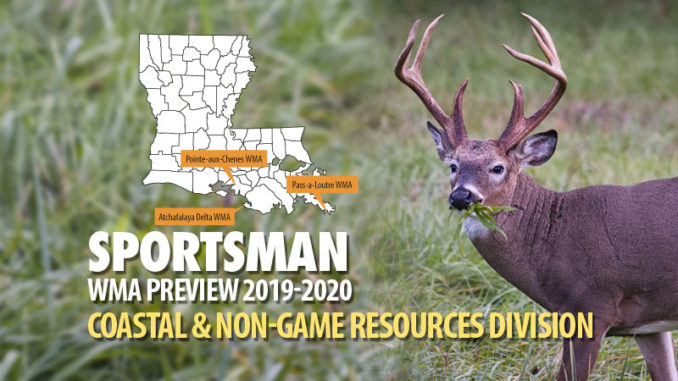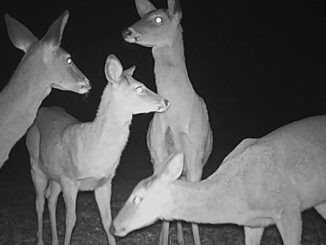
Deer
Louisiana hunters often associate the WMAs in the Coastal & Nongame Resources Division as some of the best areas to knock down ducks in the Sportsman’s Paradise.
Others realize they are prime areas for hunting deer, both quantity and quality. No one knows that more than Vaughan Campbell, an LWDF biologist who has managed the CNR divsion for the past 2½ years.
Those great deer-hunting WMAs are led each season by the Atchafalaya Delta WMA. Vaughan notes that while the deer harvest has “trended down” there, the average still is pretty darned high for the past five seasons: 136 harvested by bowhunters alone each of those seasons, according to self-clearing permits. The five-year average deer harvest there entering last season was 152.
Will a prolonged high-water event, Atchafalaya River flooding for more than six months, adversely affect the Atchafalaya Delta? And will flooding do the same to Pass-a-Loutre WMA, another top destination at the mouth of the Mississippi River?
It remains to be seen, but there are higher “spoiler islands” where deer take refuge on the Atchafalaya Delta WMA, he said. The river’s height will be a plus in the long run, because it carries sediment that drops and forms more delta.
“One of the positives with the high river for Pass-a-Loutre and the Atchafalaya Delta is they are getting dirt down there and a lot of dirt,” which will be beneficial, Campbell said.
Atchafalaya’s Main Delta
This 15,000 acres of marsh habitat is open for only adult archery hunts and annual youth lottery gun hunts.
“Atchafalaya Delta will most always be the premier coastal area due to its numerous acres of higher-elevation spoil islands at the Main Delta, which serve as great semi-upland deer habitat,” he said. “Approximately 82 deer were harvested by bowhunters and youth hunters.
“We expect a harvest similar to previous years for the 2019-20 season. Atchafalaya Delta staff continue to maintain shooting/access lanes on Big Island, which provide good conditions for deer and hunters.”
Big deer almost always show up in the harvest. Last season, on the Atchafalaya Delta WMA 10 deer were taken with at least one main antler beam 15 inches or longer; six deer had at least one antler base of 4 inches or more in circumference, and 12 deer were 8- to 10-pointers.
Here’s a list of the larger bucks harvested in 2018-19 at Atchafalaya Delta WMA:
- 180-pound, 8-point buck with a 13½-inch inside spread;
- 170-pound, 9-point buck with a 14½-inch inside spread;
- 165-pound, 5-point buck with a 10½-inch inside spread;
- 160-pound, 9-point buck with a 16½-inch inside spread;
- 150-pound, 10-point buck with a 16½-inch inside spread;
- 150-pound, 8-point buck with a 12¾-inch inside spread.
Pass-A-Loutre is the second-best bet for harvesting a trophy buck, Cambell said. Only bucks can be harvested there. Two of 11 reported harvested last season were 8-pointers weighing 190 and 175 pounds.
Participation can be a bit low at times because of its remoteness and accessibility, but it is a “great place to hunt deer” for those who are willing to put in the effort, Campbell said, noting that staffers continue to maintain shooting lanes at the Reservoir and wildlife openings across the WMA.
Ducks
Average waterfowl success — or better — is expected on many of the CNR Division’s WMAs, including Pass-a-Loutre WMA, Atchafalaya Delta WMA and Salvador/Timken WMA. At Pointe-aux-Chenes WMA, waterfowl usage is suspected to be the lowest in the PAC Unit due to reduced amounts of available food.
“Pass-a-Loutre and Atchafalaya Delta WMAs are always popular duck-hunting locations due to the high productivity and attractiveness of deltaic marshes to waterfowl. These two areas will probably be the premier coastal areas for the 2019-20 season if hurricane/tropical storm activity is low during the summer and fall of 2019,” Campbell reported.
Duck hunters can see the productivity in the numbers based on 11 bag checks and not for the entire season:
All WMAs combined: 4,103 hunter efforts/1.9 ducks per hunter effort;
Atchafalaya Delta WMA: 1,540 hunter efforts/2.0 ducks per hunter effort;
Pass-a-Loutre WMA: 665 hunter efforts/3.3 ducks per hunter effort;
Pointe-aux-Chenes WMA: 1,573 hunter efforts/1.4 ducks per hunter effort;
Salvador WMA: 235 hunter efforts/0.5 ducks per hunter effort;

The table is being set just right, barring tropical weather systems, he said, noting habitat conditions have been good this summer on most coastal WMAs due to high river stages and tides and the lack of major hurricanes or significant tropical storms the past seven years. Those high river stages accelerated wetland creation and subsequent waterfowl habitat development on active deltas, he said.
Also, flooding temporarily reduces submerged aquatic vegetation and many SAVs are important food sources for waterfowl.
Squirrels
Campbell said Pointe-aux-Chenes and Lake Bouef WMAs are the only coastal WMAs that have noteworthy populations of squirrels, and that squirrel hunting is most popular on the Point Farm Unit of Pointe-aux-Chenes WMA.
Point Farm, he said, is approximately 1,500 acres of forested habitat, including more than 500 acres of hardwood trees planted in past mitigation projects. Also, current management activities by staff, such as maintaining shooting/access lanes, provide improved conditions that help squirrels and hunters, he said.
“Each year, habitat conditions for squirrels improve at Pointe-aux-Chene WMA’s Point Farm,” Campbell reported.
COASTAL AND NON-GAME RESOURCES DIVISION
PROS
Atchafalaya Delta WMA and Pass-a-Loutre WMA, will benefit from extended high-water levels of the Atchafalaya River and Mississippi River, respectively, because they will increase delta splay development and create more waterfowl habitat.
Pass-a-Loutre WMA will benefit from “significant improvements” to several of its campgrounds over the next several years, including more docks, elevation of three campgrounds and, possibly, enlarging one campground. Also, several new crevasses are planned that will give hunters improved access to the interior and create better habitat for waterfowl.
Pointe-aux-Chenes WMA, a popular destination for dove hunting (5.02 average doves per hunter, based on self-clearing permits, on opening day 2018-19), is looking good conditions-wise and doves were using the fields in July. The outlook is good if conditions stay the same and there is no excessive rainfall.
CONS
Pointe-aux-Chenes WMA and Montegut Units have below average submerged aquatic vegetation because, biologists believe, of high water turbidity and salinity. Unmanaged areas east of Grand Bayou have below-average SAV production and continue to deteriorate because there little protection from salinities and high tide.
Salvador WMA’s waterfowl habitat has declined the past several years because increasing waterfowl hyacinth, salvinia and emergent vegetation growth reduced shallow, open-water habitats favored by ducks. Continued reduction likely will lead to reduction in waterfowl numbers, a long-term concern for the WMA.
Check out the other regions below:
Hammond Region
Lafayette Region
Lake Charles Region
Minden Region
Monroe Region
Pineville Region

